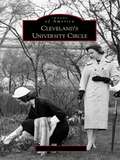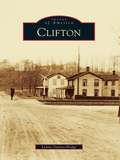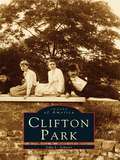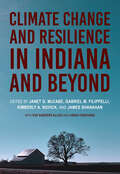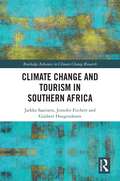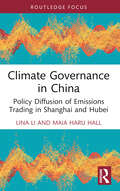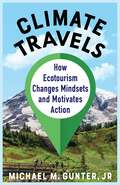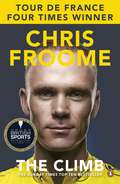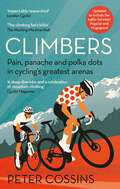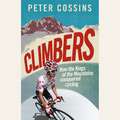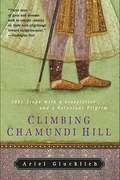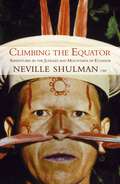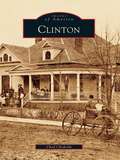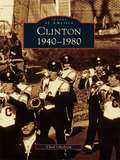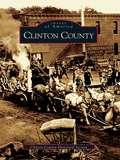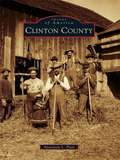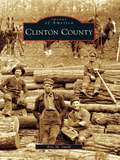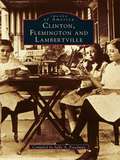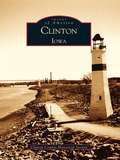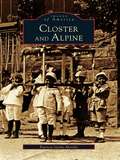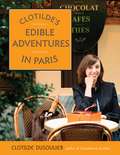- Table View
- List View
Cleveland's Flats
by Matthew Lee GrabskiCleveland is home to many fascinating neighborhoods and districts. Perhaps the most intriguing, however, is an area known as the Flats. Typically, the term "Flats" refers to the northern portion of the Cuyahoga River Valley. The Cuyahoga River ceases to be the idyllic flow of water seen to the south of Cleveland as it approaches the city's steel mills. The river is more man-made than natural where it meets the Flats, and a wide array of industries sit along its banks. The Flats have been a vital component and a reflection of Cleveland's rise, decline, and ongoing renaissance. Cleveland's Flats is a chronicle of this remarkable region. From the refineries of Standard Oil to massive ore boats carefully navigating the Cuyahoga, Cleveland's Flats treats the reader to scenes found in no other place.
Cleveland's University Circle (Images of America)
by Wayne KehoeFrom art exhibitions and natural wonders of the planet to world-class music and dazzling theater, University Circle is Cleveland's cultural, educational, and civic showpiece. Found in its one square mile are arts and sciences, museums and parks, galleries and restaurants. The circle area began as the turnaround for the Euclid Avenue streetcar in the 19th century and has developed into the cultural capital of Cleveland, as it is home to the Cleveland Museum of Art, the Cleveland Cultural Gardens, Case Western Reserve University, and the Cleveland Orchestra. Its buildings and gardens are only part of the story; the people are at the real heart of the circle--from such philanthropists as John D. Rockefeller and Jeptha Wade to Dr. George Crile and the Mathers family. And then there are the multitudes of students, immigrants, and workers who have called the circle their home.
Clifton
by Lynne Garvey-HodgeThe historic town of Clifton, Virginia, is an enchanting relic of a time past. This quarter-mile-square town of 225 inhabitants has seen little change since the early 20th century. Twenty-seven miles from the nation's capital, this little gem of yesterday is often missed by busy commuters. Clifton was originally a Native American hunting ground, then a large plantation, and eventually became known as Devereux Station, named for J. H. Devereux, overseer of the Union army's railroad construction. Harrison Otis settled here and built the handsome Clifton Hotel. Local hot springs, shops, lumber industry, schools, and churches soon created a thriving, progressive area of commerce. Originally named Clifton Station, Clifton was later incorporated in 1902. It was the first community in Fairfax County with a black Baptist church, electricity, and a high school, and it has hosted visitors as varied as Presidents Hayes and Garfield, actress Helen Hayes, First Lady Nancy Reagan, and Sleepless in Seattle author Jeff Arch. Clifton has been and is still a gentle, picturesque village.
Clifton Park (Images of America)
by John L. SchererVivid and entrancing, the images of Clifton Park contained within this volume span more than a century of memories. Residents of the area, both natives and newcomers, will find a strong connection with the faces and places presented. Rare photographs of Clifton Park, many never before published, provide a glimpse of life from 1875 to 1950. We experience the area's gradual transition, from its agricultural roots through the era of the Erie Canal and the railroads to the early years of the automobile. Through pictures of local industries, shaded dirt roads, homes, and amusement parks, we learn how early Clifton Park residents worked and played. The book also features views of local taverns, general stores, churches, and schools--all the foundations of a changing, strong, and growing community.
Climate Change and Resilience in Indiana and Beyond
by Jeffrey S. Dukes Melissa Widhalm Janet G. McCabe Gabriel M. Filippelli Kimberly A. Novick James Shanahan Ben Kravitz Douglas Edmonds Chanh Kieu Travis A. O'Brien Scott Robeson Paul Staten Brian Yanites Chen Zhu Sarah Mincey Rebecca Lave John Baeten Justin Maxwell Richard Phillips Ellen D. Ketterson Daniel Becker Geoffrey Brown Allison Byrd Keith Clay Adam Fudickar Matthew Houser Alex Jahn Jennifer Ann Lau Sarah Wanamaker James Robert Farmer Elizabeth Grennan Browning Heather L. Reynolds Samantha L. Hamlin Dana Habeeb Jeffrey S. Wilson Daniel Myers Eric Sandweiss Beth Edwards Nathan Geiger Andrea Webster David M. Konisky Nikolaos Zirogiannis Sanya Carley Eva Sanders Allen Lingxi ChenyangClimate change is affecting Indiana's environment, threatening the way Hoosiers live and do business, and introducing new stresses to the state's economy, health, and infrastructure. And while scientists predict more days of extreme weather, increased public health risks, and reduced agricultural production in the coming years, Hoosiers still have a substantial say in determining their future environment. Climate Change and Resilience in Indiana and Beyond confirms that Indiana can rise to meet this threat. The culmination of Indiana University's Prepared for Environmental Change Grand Challenge, this collection showcases how scientists, policymakers, communicators, and others are working hard to protect Indiana's economy and way of life by becoming more resilient. Researchers are creating new environmental resilience frameworks, building on years of existing research on how ecosystems can adapt, how social systems process threats in order to change, and how individuals themselves fit into the larger picture. In addition to presenting research results, Climate Change and Resilience in Indiana and Beyond provides clear examples of how Hoosiers can make a difference by reducing risks, lessening the harmful impacts of climate change, and preparing for the unavoidable.What emerges in these pages is a hopeful, optimistic picture of how resilience is generalizable across systems—from forests to farms to cities—and how Hoosiers are mobilizing this resilience in the face of climate change.
Climate Change and Tourism in Southern Africa (Routledge Advances in Climate Change Research)
by Jarkko Saarinen Jennifer Fitchett Gijsbert HoogendoornThis book explores the nature of climate change in southern Africa, its impacts on tourism and the resilience, adaptation and governance needs in various tourism operations and environments. Previous studies on climate change and tourism have mainly focused on the Global North and specific forms of tourism such as snow-based winter activities. Drawing on case studies from a wide range of countries including South Africa, Lesotho, Namibia, Botswana and Zimbabwe, this book fills this lacuna by describing and analysing the climate change and tourism nexus in the southern African context. The book begins by providing an overview of the current and estimated impacts of climate change to the tourism industry in the region, highlighting the deepening socio-economic inequities, and environmental and social injustices. It focuses on the importance of sustainable tourism in tackling these issues and highlights that resilience and robust governance and policy systems are essential for a tourism destination to successfully adapt to change. By synthesising the key lessons learned through this analysis, Climate Change and Tourism in Southern Africa also draws attention to specific adaptation and policy strategies which have value for other regions in the Global South. This book will be of great interest to students and scholars of climate change, tourism and environmental policy and justice.
Climate Governance in China: Policy Diffusion of Emissions Trading in Shanghai and Hubei (Routledge Focus on Environment and Sustainability)
by Lina Li Maia Haru HallThis book explores how and why innovative climate policies spread across subnational regions and between governance levels in China. Despite the significance of emerging economies in a pathway to a zero-carbon future, research to date on China’s transformation governance remains limited. Drawing on a theoretical framework for policy diffusion and based on extensive data from expert interviews with Chinese decisionmakers and policy practitioners, Lina Li and Maia Haru Hall focus on the policy of emissions trading systems (ETS) and two key case studies: Shanghai and Hubei. The authors examine the role of the national government and how much freedom the subnational regions have in developing ETS policy, as well as pinpointing key actors and the role of policy and knowledge diffusion mechanisms. Overall, this book sheds light on the competition between China and the West in the transition to climate-friendly societies and economies, highlighting opportunities for cooperation between them. This book will be of great interest to students and scholars of environmental politics and policy, climate change, urban studies, and Chinese studies more broadly.
Climate Travels: How Ecotourism Changes Mindsets and Motivates Action
by Michael M. Gunter Jr.Many accounts of climate change depict disasters striking faraway places: melting ice caps, fearsome hurricanes, all-consuming fires. How can seeing the consequences of human impacts up close help us grasp how global warming affects us and our neighbors? This book is a travelogue that spotlights what a changing climate looks like on the local level—for wherever local happens to be.Michael M. Gunter, Jr. takes readers around the United States to bear witness to the many faces of the climate crisis. He argues that conscientious travel broadens understanding of climate change and makes its dangers concrete and immediate. Vivid vignettes explore the consequences for people and communities: sea level rise in Virginia, floods sweeping inland in Tennessee, Maine lobsters migrating away from American territorial waters, and imperiled ecosystems in national parks, from Alaskan permafrost to the Florida Keys. But Gunter finds inspiring initiatives to mitigate and adapt to these threats, including wind turbines in a tiny Texas town, green building construction in Kansas, and walkable urbanism in Portland, Oregon. These projects are already making a difference—and they underscore the importance of local action.Drawing on interviews with government officials, industry leaders, and alternative energy activists, Climate Travels emphasizes direct personal experience and the centrality of environmental justice. Showing how travel can help bring the reality of climate change home, it offers readers a hopeful message about how to take action on the local level themselves.
The Climb: The Autobiography
by Chris FroomeOn 26th July 2015, Chris Froome entered the record books. He won cycling's ultimate race - the Tour de France - for the second time.Taking a double Yellow Jersey was a staggering achievement. This memoir shows just how remarkable it was, given the uphill struggle Froome faced. Growing up in Kenya, biking down mile after mile of dusty road, and staying in a humble tin hut, he developed a fierce passion and determination to win.The road to Europe was long, gruelling and filled with setbacks - but it prepared him for teamwork as a domestique and then the leap to leader of Team Sky and a shot at winning the Tour de France. In The Climb, written with the renowned investigative reporter David Walsh, he vividly recounts the struggles, the rivalries, the battles, the comebacks. Finally he traces his path to triumph and his mission to help clean up cycling.Inspiring and exhilarating, it will leave you ready to face your own challenges in life, whatever they may be.'Engaging, vividly evoked' Mail on Sunday, Books of the Year'What Chris has done is phenomenal' Sir Chris Hoy
Climbers: How the Kings of the Mountains conquered cycling
by Peter CossinsWhen, during the Pyrenean stages of the 1998 Tour de France, a journalist asked Marco Pantani why he rode so fast in the mountains, the elfin Italian, unmistakeable in the bandanna and hooped ear-rings that played up to his "Pirate" nickname, replied: "To shorten my agony."Drawing on the fervour for these men of the mountains, Climbers looks at what sets these athletes apart within the world of bike racing, about why we love and cherish them, how they make cycling beautiful, and how they see themselves and the feats they achieve.Working chronologically, Peter Cossins explores the evolution of mountain-climbing. He offers a comprehensive view of the sport, combining contemporary reports with fresh one-to-one interviews with high-profile riders from the last 50 years, such as Cyrille Guimard, Hennie Kuiper and Andy Schleck. And, unlike many other cycling books, Climbers also includes the stories of female racers across the world, from Ashleigh Moolman-Pasio and Annemiek van Vleuten to Fabiana Luperini and Amanda Spratt.Climbers analyses the personalities of these racers, highlighting the individuality of climbing as an exercise and the fundamental fact that it's a solitary challenge undertaken in relentlessly unforgiving terrain that requires unremitting effort.Captivating and iconic, Climbers is the ultimate cycling book to understand what it takes both physically and mentally to take on the sport's hardest stages.
Climbers: How the Kings of the Mountains conquered cycling
by Peter CossinsWhen, during the Pyrenean stages of the 1998 Tour de France, a journalist asked Marco Pantani why he rode so fast in the mountains, the elfin Italian, unmistakeable in the bandanna and hooped ear-rings that played up to his "Pirate" nickname, replied: "To shorten my agony."Drawing on the fervour for these men of the mountains, Climbers looks at what sets these athletes apart within the world of bike racing, about why we love and cherish them, how they make cycling beautiful, and how they see themselves and the feats they achieve.Working chronologically, Peter Cossins explores the evolution of mountain-climbing. He offers a comprehensive view of the sport, combining contemporary reports with fresh one-to-one interviews with high-profile riders from the last 50 years, such as Cyrille Guimard, Hennie Kuiper and Andy Schleck. And, unlike many other cycling books, Climbers also includes the stories of female racers across the world, from Ashleigh Moolman-Pasio and Annemiek van Vleuten to Fabiana Luperini and Amanda Spratt.Climbers analyses the personalities of these racers, highlighting the individuality of climbing as an exercise and the fundamental fact that it's a solitary challenge undertaken in relentlessly unforgiving terrain that requires unremitting effort.Captivating and iconic, Climbers is the ultimate cycling book to understand what it takes both physically and mentally to take on the sport's hardest stages.
Climbers: How the Kings of the Mountains conquered cycling
by Peter CossinsWhen, during the Pyrenean stages of the 1998 Tour de France, a journalist asked Marco Pantani why he rode so fast in the mountains, the elfin Italian, unmistakeable in the bandanna and hooped ear-rings that played up to his "Pirate" nickname, replied: "To shorten my agony."Drawing on the fervour for these men of the mountains, Climbers looks at what sets these athletes apart within the world of bike racing, about why we love and cherish them, how they make cycling beautiful, and how they see themselves and the feats they achieve.Working chronologically, Peter Cossins explores the evolution of mountain-climbing. He offers a comprehensive view of the sport, combining contemporary reports with fresh one-to-one interviews with high-profile riders from the last 50 years, such as Cyrille Guimard, Hennie Kuiper and Andy Schleck. And, unlike many other cycling books, Climbers also includes the stories of female racers across the world, from Ashleigh Moolman-Pasio and Annemiek van Vleuten to Fabiana Luperini and Amanda Spratt.Climbers analyses the personalities of these racers, highlighting the individuality of climbing as an exercise and the fundamental fact that it's a solitary challenge undertaken in relentlessly unforgiving terrain that requires unremitting effort.Captivating and iconic, Climbers is the ultimate cycling book to understand what it takes both physically and mentally to take on the sport's hardest stages.(p) 2021 Octopus Publishing Group
Climbing Chamundi Hill
by Ariel GlucklichAn American traveler in India chances upon an old storyteller, who joins him on his pilgrimage to the top of a holy hill and along the way shares the authentic flavor of India through stories of courtesans and kings, holy men and thieves, talking animals, and mythical lands. Many of them are translated here by Glucklich for the first time from the ancient Sanskrit.
Climbing the Equator
by Neville ShulmanCreatures from another time, volcanic mountains five million years old, Indian tribes surviving from the pre-Inca period, jungles and rainforests: Ecuador has all this and more. Only in its Galapagos Islands did Charles Darwin discover such a variety of extraordinary fauna that on his return to England he wrote his groundbreaking On the Origin of Species. With a philosophical yet humourous approach, Neville Shulman provides an in-depth background to Ecuador and its diverse peoples and tells intriguing stories of spectacular creatures and exotic flora, many not found anywhere else in the world.
Climbing the Equator
by Neville ShulmanCreatures from another time, volcanic mountains five million years old, Indian tribes surviving from the pre-Inca period, jungles and rainforests: Ecuador has all this and more. Only in its Galapagos Islands did Charles Darwin discover such a variety of extraordinary fauna that on his return to England he wrote his groundbreaking On the Origin of Species. With a philosophical yet humourous approach, Neville Shulman provides an in-depth background to Ecuador and its diverse peoples and tells intriguing stories of spectacular creatures and exotic flora, many not found anywhere else in the world.
Clinton
by Chad ChisholmClinton, Mississippi, is the home of Mississippi College, the state's oldest existing institution of higher learning. Clinton produced statesmen such as Walter Leake, writers and artists such as Barry Hannah and Wyatt Waters, and modern celebrities such as Lance Bass and Mandy Ashford. Today Clinton serves as a bedroom community for Jackson. Clinton began as the Mount Dexter trading post on the Old Natchez Trace. The town was founded as Mount Salus in 1823 by Walter Leake, one of Mississippi's first U.S. senators and the third governor. Six years later, Clinton fell one vote short of becoming the state capital. Through antebellum prosperity, occupation by Union troops, rebirth as a college community, and growth into a postwar suburban center, Clinton and its people have been marked by independence. This pictorial history is a chronicle of Clinton's most indelible individuals, families, and institutions.
Clinton: 1940-1980 (Images of America)
by Chad ChisholmIn 1940, the town of Clinton had scarcely grown in size or population since the Civil War. However, the coming of World War II forever changed the identity of this small Southern college town. Aside from the sudden departure of its best and brightest men and women for the front lines, global war touched Clinton in the form of a German POW camp and a Navy V12 training school at Mississippi College. Clinton: 1940-1980 picks up where author Chad Chisholm ended his previous book, with Clinton in the midst of postwar growth. It is a chronicle of Clinton's living history, a treasury of photographs for all Clintonians.
Clinton County (Images of America)
by Clinton County Historical SocietyBefore settlers first arrived in the 1800s, Clinton County rested full of promise along the western edge of the Mississippi River. In the years that have passed, it has become an area of great commercial, agricultural, and industrial accomplishments. From the initial settlement of Lyons, DeWitt, and Camanche, where axe and oxen were prevalent on the scene, to the modern communities that are now home to astronauts and artisans, this book illustrates the incredible growth that has occurred over nearly two centuries. Through over 200 historical photographs, the Clinton County Historical Society documents how Clinton County has become a national treasure of culture and character.
Clinton County (Images of America)
by Anastasia L. PrattFirst permanently settled after Samuel de Champlain's voyages through the region and officially chartered in 1788, Clinton County offers a host of agricultural and industrial pursuits. With a rich military history, the county was pivotal in the American Revolution as the birthplace of the U.S. Navy. Life in the county has been greatly enhanced by strong family traditions, religious celebrations, and social justice movements like the Underground Railroad. Clinton County is home to the city of Plattsburgh, the towns of Altona, Au Sable, Beekmantown, Black Brook, Champlain, Chazy, Clinton, Dannemora, Ellenburg, Mooers, Peru, Plattsburgh, Saranac, and Schuyler Falls, and the villages of Champlain, Dannemora, Keeseville, and Rouses Point.
Clinton County
by Eric M. SmithClinton County was originally inhabited by the Shawnee, Lenape, and Iroquois tribes. Lumber was abundant, and it drew in settlers searching for a home and work. A diversity of industry developed as people settled in the area, from brickwork in Farrandsville and Mill Hall to the heyday of the Piper Cub and Piper Aviation. During 1889, 1918, 1936, and 1972, floods tore through the county beforea levee system was finally constructed in Lock Haven in the 1990s. Education has been an important mainstay in the area, and one-room schoolhouses once dotted the landscape. The Central State Normal School, now Lock Haven University, was a regional draw for those seeking a career in teaching. Through historic photographs, Clinton County illustrates the changes that have occurred in this area over the years and traces the history of the people who created this heartland Pennsylvania community.
Clinton, Flemington, and Lambertville (Images of America)
by Sally A. FreedmanLife among the rolling hills of northwest New Jersey and in the three small towns that became centers of that area's population has been faithfully recorded by residents since the Civil War, capturing the rural character of their landscape. The rich heritage of descendants of English, Dutch, and German settlers in the Hunderton County population centers of Clinton, Flemington, and Lambertville is presented here.
Clinton, Iowa (Images of America)
by Clinton County Historical SocietySince settlers first touched upon its shores in 1835, the city of Clinton, Iowa has evolved from a humble trading post on the Mississippi River into a vibrant city of thriving commerce, majestic homes, and riverfront splendor. Once the largest lumber milling center in the world, Clinton has long possessed a rich cultural heritage and a pioneering spirit. This book documents and explores the history of this proud community through a unique collection of historical photographs.
Closter and Alpine
by Patricia Garbe-MorilloCloster and Alpine are situated on the slopes of the Palisades cliffs, tucked into the northeastern corner of New Jersey. Rising some five hundred feet above the Hudson River, the peaks of these cliffs offer some of the most spectacular scenery in the state. On these slopes the earliest pre-Revolutionary settlements were established and nineteenth- and twentieth-century mansions were built. Closter and Alpine includes the region's earliest history, beginning with "Wooly," the ten-thousand-year-old long-haired mastodon discovered in 1974. The 1776 British invasion led by Lord Cornwallis and the cruel murder of ninety-year-old Douwe Tallman were early local events of the Revolutionary War. During the nineteenth century, the freed slave community of Skunk Hollow was founded, a community to which present Closter residents can trace roots. One of the most unique parts of the history of Closter and Alpine are the "Houses like Fords," the "assembly-line" homes built by the Lustron Corporation during the post-World War II housing shortage. Closter and Alpine have the only two of these houses remaining in Bergen County.
Clotilde's Edible Adventures in Paris
by Clotilde DusoulierClotilde Dusoulier, a native Parisian and passionate explorer of the city’s food scene, has won a tremendous following online with her insider reports and wonderful recipes on her blog, www. chocolateandzucchini. com. Her book,Chocolate and Zucchini, introduced her to a wider, equally enthusiastic audience. Now inClotilde’sEdible Adventures in Paris,Clotilde reveals her all-time favorite food experiences in her native city. She takes us on a mouthwatering tour of the restaurants, markets, and shops she loves the most: from the best places to go for lunch, tea, or a glass of wine, to “neo bistros” and the newest places to find spectacular yet affordable meals. Packed with advice on everything from deciphering a French menu to ordering coffee correctly, this book is like having Clotilde as a personal guide. A dozen tempting recipes are also included, shared or inspired by Clotilde’s favorite chefs and bakers. For first-time visitors and seasoned travelers alike,Clotilde’sEdible Adventures in Parisoffers invaluable insider recommendations on eating and shopping with Parisian panache. The best of Paris, featuring 164 restaurants, bistros, wine bars, andsalons de thé, as well as over 130 bakeries, pastry shops, cheese shops, bookstores, chocolate and candy shops, cookware and tableware stores, specialty shops, outdoor markets, and much, much more!

